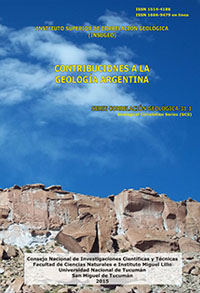Serie Correlación Geológica 31 (1)
Geología local y mineralogía accesoria de las pegmatitas berilíferas del Distrito Velasco y rocas graníticas asociadas, Provincia Pegmatítica Pampeana, Noroeste de Argentina
Fernando G. Sardi | Adriana Heimann | Janet Sarapura Martinez
Descargar trabajo en formato PDFResumen
GEOLOGÍA LOCAL Y MINERALOGÍA ACCESORIA DE LAS PEGMATITAS BERILÍFERAS DEL DISTRITO VELASCO Y ROCAS GRANÍTICAS ASOCIADAS, PROVINCIA PEGMATÍTICA PAMPEANA, NOROESTE DE ARGENTINA. Se realiza un estudio de la estructura interna de las pegmatitas y del contenido mineralógico de las pegmatitas y rocas asociadas del Distrito Velasco de la Provincia Pegmatítica Pampeana, Argentina. Las pegmatitas pertenecen a la clase de Elementos Raros, tipo berilo, subtipo berilo-columbita-fosfato, y tienen relación espacial y genética con los granitos post-orogénicos de edad Carbonífera inferior, los que presentan características de granito tipo-A. Las pegmatitas tienen formas elipsoidales, alargadas y semi-circulares, siendo la relación del eje mayor/eje menor variable, entre aproximadamente 1 y 4,7. El rumbo del eje mayor de las pegmatitas es variable para cada pegmatita. La zonación es simple; desde la parte externa hacia el interior de las pegmatitas, se observa una zona de borde de naturaleza netamente granítica, con escasa a nula biotita; una zona intermedia, con sub-zonas de acuerdo al mineral de feldespato predominante; y finalmente, un núcleo de cuarzo. El microclino gráfico y pertítico de la zona intermedia presenta en algunas pegmatitas un reemplazamiento por plagioclasa. La mineralogía accesoria de los granitos parentales incluye: biotita, muscovita, apatita, fluorita, circón, ilmenita, magnetita, uraninita y xenotima; en el borde de las pegmatitas, muscovita, biotita, apatita, circón, monacita, fluorita, columbita-tantalita, ilmenita, rutilo, pirita, calcopirita, thorita; y en la zona intermedia, muscovita, biotita, berilo, apatita, triplita, turmalina, granate.
Abstract
LOCAL GEOLOGY AND ACCESORY MINERALOGY OF BERYL-PEGMATITES AND GRANITIC ROCKS OF THE VELASCO DISTRICT, PAMPEANA PEGMATITE PROVINCE, NORTHWESTERN ARGENTINA. A study of the internal structure of the pegmatites and its mineralogy and associated granitic rocks from the Velasco district of the Pampean Pegmatite Province (Argentina) is presented. The pegmatites belong to the Rare Elements class, beryl type, beryl-columbite-phosphate subtype. They have spatial and genetic relationship to Carboniferous A-type granites. The pegmatites have ellipsoidal, elongated and semi-circular morphologies, being the major axis/minor axis ratio between 1 and 4.7. The direction of the major axis is variable for each pegmatite. The zoning is simple. From the outside inwards, the following internal zones could be recognized in the pegmatites: border zone, intermediate zone and quartz core. The graphic and pertitic microcline of the intermediate zone is replaced by plagioclase in some pegmatites. The accessory mineralogy is: for the parental granites, biotite, muscovite, apatite, fluorite, zircon, ilmenite, magnetite, uraninite and xenotime; for the border of the pegmatites, muscovite, biotite, apatite, zircon, monazite, fluorite, columbite-tantalite, ilmenite, rutile, pyrite, chalcopyrite, thorite; and for the intermediate zone, muscovite, biotite, beryl, apatite, triplite, tourmaline, garnet.






